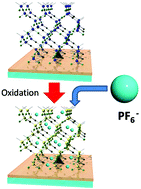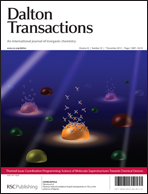A redox-active porous coordination network film based on a Ru complex as a building block on an ITO electrode†
Abstract
The combination of self-assembled monolayer (SAM) and layer-by-layer (LbL) growth methods for the construction of a surface porous film has the potential to incorporate a wide range of chemical functionalities on a solid surface. A novel redox-active Ru complex with 2,6-bis(N-pyridylbenzimidazolyl)-pyridine ligands (Ru complex 1), in which four peripheral pyridine groups act as coordination sites, was used as a building block for a porous coordination network film. By using (4-pyridyl)phenylphosphonic acid as a SAM primer layer on an ITO surface, the Ru complex 1 was immobilized by the successive reaction of PdCl2 on the ITO electrode in the LbL growth method. Multilayer growth was monitored by UV-vis spectra and cyclic voltammetry, in which the linear increases of both absorbance and the peak current were observed. This result indicated that the regular accumulation of Ru complex 1 onto the ITO surface took place. The permselectivity of the present porous coordination network structure was examined using redox-active molecular probes with different sizes and charges such as ferrocene, trimethylaminomethylferrocene, the Os bis(2,6-bis(N-methylbenzimidazolyl)-pyridine) complex, and tetrathiofulvarene (TTF). With the Os complex and cationic ferrocene, only the catalytic peak was observed as a prewave of the adsorbed Ru(II/III) peak at +0.73 V. On the other hand, the oxidation peak of ferrocene was observed around 0 V vs. Fc+/Fc even for nine-layered films in addition to the adsorbed Ru(II/III) peak. From these results, not only molecular size but also electrostatic interaction plays an important role in the permeation into the Ru complex 1 porous network film.

- This article is part of the themed collection: Coordination Programming: Science of Molecular Superstructures Towards Chemical Devices

 Please wait while we load your content...
Please wait while we load your content...